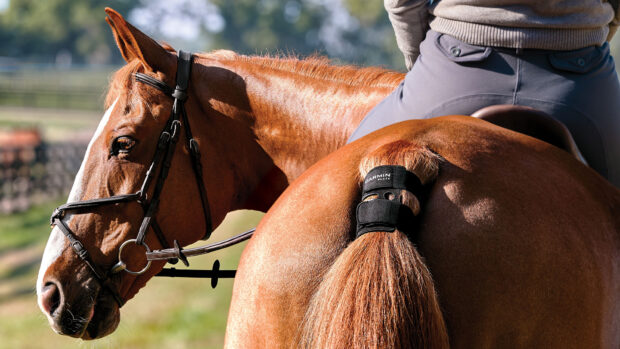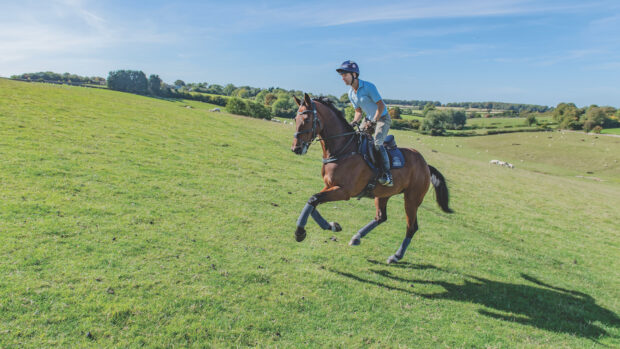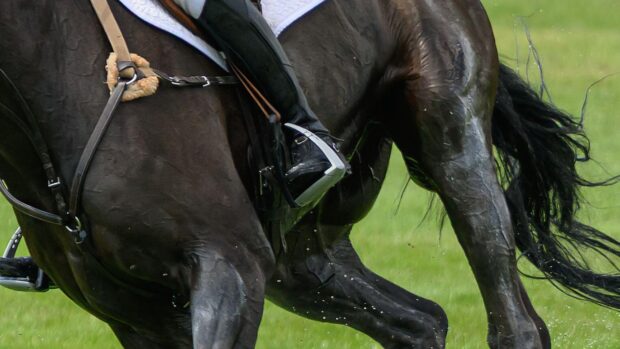As we are well into the summer season and enjoying typically British indecisive spells of warm sunshine and heavy downpours, horses may find their waistlines increasing as the grass continues to grow.
But for companion horses, who often are at grass 24/7 and may not be ridden, shifting the weight can be difficult.
A study found that horses that were exercised five times a week, with sessions made up of 15 minutes of trot and 5 minutes of brisk walking before and after, enjoyed a range of benefits including reduced laminitis risk — a particular concern for any overweight equines.
Here are six ideas to help exercise non-ridden horses who are healthy and sound enough to be exercised.
In-hand horse agility
Vanessa Bee, founder of horse agility and The International Horse Agility Club, explains why horse agility (pictured throughout) can be ideal for companion equines: “Horse agility is a discipline and internationally competitive sport in which horse and handler, both on foot, navigate a course of obstacles while focusing on clear communication and positive horsemanship.
“It is ideal for the companion or un-ridden horse, pony, donkey or mule because, not only does it keep the horse physically active, it encourages him to think. After a few training sessions the horse realises he is never pressured to just ‘do’ the obstacle but is allowed to be curious and explore it. In that way he not only keeps his body healthy, but also his mind.”
Find out more about horse agility and how to get started on the club’s website.

Lungeing
Lungeing can be used as part of a fit horse’s exercise regime, although it is recommended it is used in moderation as the constant circling will challenge the joints, tendons and muscles. When performed well, it can improve a horse’s suppleness and balance so will be beneficial for non-ridden horses too.
Short lungeing sessions comprising of walk and trot could be incorporated into the routine of a companion horse to help build their fitness and burn extra calories. But it should be introduced gradually and while keeping in mind that it is quite an intense work out.
Free schooling
If you have access to an arena, or even a fenced off area of the field (as long as your horse can resist the grass!) then free schooling can be a fun, simple way to help your horse exercise. In the enclosed area, use a lunge whip to encourage your horse to move on around the area, varying his paces as required.
You can even incorporate poles or small jumps if your horse is fit enough to add variety to free schooling sessions.
Using a track system for exercise in the field
Track systems are praised for increasing the amount horses move while turned out, as they are motivated to keep walking from their hay to their water source, and back again.
Although far from scientific, a waterproof GPS tracker plaited into my gelding’s mane revealed that he walked 7km a day when kept on a track — much further than he would when in a small paddock for restricted grazing.
A basic grass track system can be relatively easy to set-up with electric fencing around the perimeter of a paddock.
Long-reining hacks
Who says happy hacking is just for riders? Why not try long-reining your horse out on your favourite hacking routes?
It is important to practise long-reining at home in a safe, enclosed space before you head out into the open or onto the roads and make sure that both horse and handler is wearing hi-viz and up to date safety gear.
If long-reining is new to you or your horse, enlist the help of an instructor to show you the ropes. You’ll be out enjoying the countryside together in no time.
Ponying or ride and lead
This is another one best practised at home before venturing out — you don’t want to find yourself tanking up the lane with not one, but two ponies to pull up!
Ponying, also known as ride-and-lead, involves leading one horse off another while riding. It can suit owners with multiple horses, as two can be exercised at the same time. However, it’s important to ensure that the horses get along as they will be in close proximity to one another, and that you have adequate control of both horses.
Practise stopping, moving off, turning and negotiating obstacles you may find out hacking in the arena or field at home before you try heading further afield.
Safety first
Remember to take into account the health, soundness and fitness of any horse before exercising them, and seek advice from your vet and relevant professionals if needed. Even if you are working your horse from the ground, be sure to use up-to-date safety gear, including a helmet, and if you’re leaving the yard don’t forget the hi-viz!
You might also like:

Fancy trying your hand at horse agility? Here’s what you need to know first…

How to ride and lead horses together safely

How to lunge a horse – your essential guide

Riding from the ground: the benefits of long reining and how to do it

Subscribe to Horse & Hound magazine today – and enjoy unlimited website access all year round
Horse & Hound magazine, out every Thursday, is packed with all the latest news and reports, as well as interviews, specials, nostalgia, vet and training advice. Find how you can enjoy the magazine delivered to your door every week, plus options to upgrade your subscription to access our online service that brings you breaking news and reports as well as other benefits.




